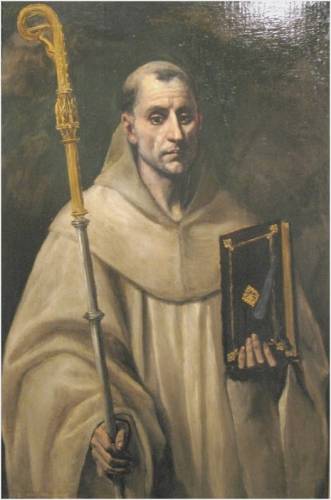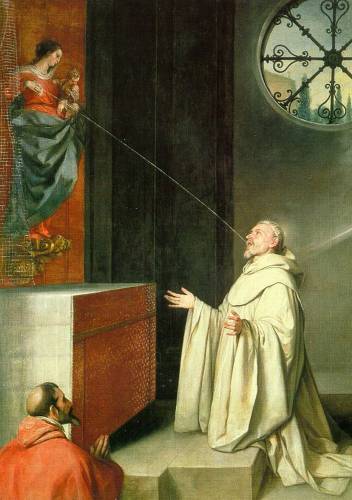Картина Эль Греко "Святой Бернар" попала в Эрмитаж после Второй Мировой войны.
Долгое время она хранилась в запасниках и не выставлялась из-за притязаний на нее Германии.
Дело разрешилось в нашу пользу и теперь её мы можем лицезреть в Испанском зале Эрмитажа.
аббат монастыря Клерво (с 1117).Бернар Клервосский придерживался мистического направления
в теологии, был активным сторонником папской теократии.
Участвовал в создании духовно-рыцарского ордена тамплиеров.
Вдохновитель второго Крестового похода 1147.
Содействовал росту монашеского ордена цистерцианцев, получивших название бернардинцев в его память.
Bernard of Clairvaux, (1090 – August 20, 1153) was a Frankish abbot and the primary builder of the reforming
Cistercian monastic order. After the death of his mother, Bernard sought admission into the Cistercian order.
Three years later, he was sent to found a new abbey at an isolated clearing in a glen known as the Val d'Absinthe,
about 15 km southeast of Bar-sur-Aube. Bernard of Clairvaux is our Patron Saint of our most esteemed Order.
He is responsible for writing the rule of the Templars. The Rule given to the Templars had as a model the Rule
of St. Benedict, influenced greatly by the reformed Cistercian version, and from this base developed their own
distinct code of military, spiritual, and everyday life. As a result, the Benedictine and Templar Rules bear
considerable similarities. Both the Templars and Benedictines prescribe leaders expecting complete obedience
and in turn showing kindness, mercy, and fatherly care. To govern successfully, these men should seek counsel
and appoint able subordinates. Elections allow the orders to choose the most capable brothers to be the head.
Both rules also create similar initiation processes, vows and duties, restrictions, and prayer procedures for the
brethren. According to tradition, Bernard founded the monastery on 25 June 1115, naming it Claire Vallée,
which evolved into Clairvaux. There Bernard would preach an immediate faith, in which the intercessor was
the Virgin Mary. In the year 1128, Bernard assisted at the Council of Troyes, at which he traced the outlines
of the Rule of the Knights Templar, who soon became the ideal of Christian nobility.
Bernard participated in the Council of Troyes, which had been convoked by Pope Honorius II, and was presided
over by Cardinal Matthew, Bishop of Albano. The purpose of this council was to settle certain disputes of the
bishops of Paris, and regulate other matters of the Church of France. The bishops made Bernard secretary
of the council, and charged him with drawing up the synodal statutes. After the council, the Bishop of Verdun
was deposed. It was at this council that Bernard traced the outlines of the Rule of the Knights Templar who
soon became the ideal of Christian nobility. He later praised them in his "De Laude Novae Militiae."
On the death of Pope Honorius II, which occurred on February 14, 1130, a schism broke out in the Church.
King Louis VI convened a national council of the French bishops at Étampes, and Bernard was chosen to
judge between the rival popes. In 1139, Bernard assisted at the Second Council of the Lateran. Bernard
denounced the teachings of Peter Abelard to the Pope, who called a council at Sens in 1141 to settle the matter.
Bernard soon saw one of his disciples, Bernard of Pisa, elected Pope. Having previously helped
end the schism within the Church, Bernard was now called upon to combat heresy.
In June 1145, Bernard traveled in Southern France and his preaching there helped strengthen support
against heresy.Following the Christian defeat at the Siege of Edessa, the Pope commissioned Bernard
to preach the Second Crusade. The last years of Bernard's life were saddened by the failure of the
crusaders, the entire responsibility for which was thrown upon him. Bernard died at age 63, after
40 years spent in the cloister. He was the first Cistercian monk placed on the calendar of saints,
and was canonized by Pope Alexander III on 18 January 1174. Pope Pius VIII bestowed upon him
the title of "Doctor of the Church."The little community of reformed Benedictines at Cîteaux, which
would have so profound an influence on Western monasticism, grew rapidly. Three years later,
Bernard was sent with a band of twelve monks to found a new house at Vallée d'Absinthe, in the
Diocese of Langres. This Bernard named Claire Vallée,or Clairvaux, on June 25, 1115, and the
names of Bernard and Clairvaux would soon become inseparable. During the absence of the Bishop
of Langres, Bernard was blessed as abbot by William of Champeaux, Bishop of Châlons-sur-Marne.
From that moment a strong friendship sprang up between the abbot and the bishop, who was
professor of theology at Notre Dame of Paris, and the founder of the Abbey of St. Victor.
The beginnings of Clairvaux Abbey were trying and painful. The regime was so austere that Bernard became ill,
and only the influence of his friend William of Champeaux and the authority of the General Chapter could make
him mitigate the austerities. The monastery, however, made rapid progress. Disciples flocked to it in great
numbers and put themselves under the direction of Bernard. His father and all his brothers entered Clairvaux
as to pursue religious life, leaving only Humbeline, his sister, in the secular world. She, with the consent
of her husband, soon took the veil in the Benedictine nunnery of Jully-les-Nonnains. Gerard of Clairvaux,
Bernard's older brother, became the cellarer of Citeaux. The abbey became too small for its members and
it was necessary to send out bands to found new houses. In 1118,
Trois-Fontaines Abbey was founded in the Diocese of Châlons, in 1119, Fontenay Abbey in the Diocese of
Autun and in 1121, Foigny Abbey near Vervins, in the Diocese of Laon. In addition to these victories, Bernard
also had his trials. During an absence from Clairvaux, the Grand Prior of Cluny went to Clairvaux and enticed
away Bernard's cousin, Robert of Châtillon. This was the occasion of the longest and most emotional of Bernard's
letters.The abbey of Cluny as it would have looked in Bernard's time.
In the year 1119, Bernard was present at the first general chapter of the order convoked by Stephen of Cîteaux.
Though not yet 30 years old, Bernard was listened to with the greatest attention and respect, especially
when he developed his thoughts upon the revival of the primitive spirit of regularity and fervour in all the
monastic orders. It was this general chapter that gave definitive form to the constitutions of the order and
the regulations of the "Charter of Charity" which Pope Callixtus II confirmed December 23, 1119. In 1120,
Bernard authored his first work "De Gradibus Superbiae et Humilitatis" and his homilies which he entitled
"De Laudibus Mariae." The monks of the abbey of Cluny were unhappy to see Cîteaux take the lead rôle
among the religious orders of the Roman Catholic Church. For this reason, the Black Monks attempted to
make it appear that the rules of the new order were impracticable. At the solicitation of William of St. Thierry,
Bernard defended the order by publishing his "Apology" which was divided into two parts. In the first part,
he proved himself innocent of the charges of Cluny and in the second he gave his reasons for his counterattacks.
He protested his profound esteem for the Benedictines of Cluny whom he declared he loved equally as well as
the other religious orders. Peter the Venerable, Abbot of Cluny, answered Bernard and assured him of his great
admiration and sincere friendship. In the meantime Cluny established a reform, and Abbot Suger, the minister
of Louis VI of France, was converted by the Apology of Bernard. He hastened to terminate his worldly life and
restore discipline in his monastery. The zeal of Bernard extended to the bishops, the clergy, and lay people.
Bernard's letter to the Archbishop of Sens was seen as a real treatise, "De Officiis Episcoporum."
About the same time he wrote his work on Grace and Free Will.
The death of his contemporaries served as a warning to Bernard of his own approaching end. The first to die
was Suger in 1152, of whom Bernard wrote to Eugenius III, "If there is any precious vase adorning the palace
of the King of Kings it is the soul of the venerable Suger". Conrad III and his son Henry died the same year.
From the beginning of the year 1153, Bernard felt his death approaching. The passing of Pope Eugenius had
struck the fatal blow by taking from him one whom he considered his greatest friend and consoler. Bernard
died at age sixty-three on August 20, 1153, after forty years spent in the cloister. He was buried at the
Clairvaux Abbey, but after its dissolution in 1792 by the French revolutionary government, his remains were
translated to the Troyes Cathedral.
References
http://en.wikipedia.org/wiki/Bernard_of_Clairvaux
http://www.the-orb.net/encyclop/religion/monastic/comprule.html
















